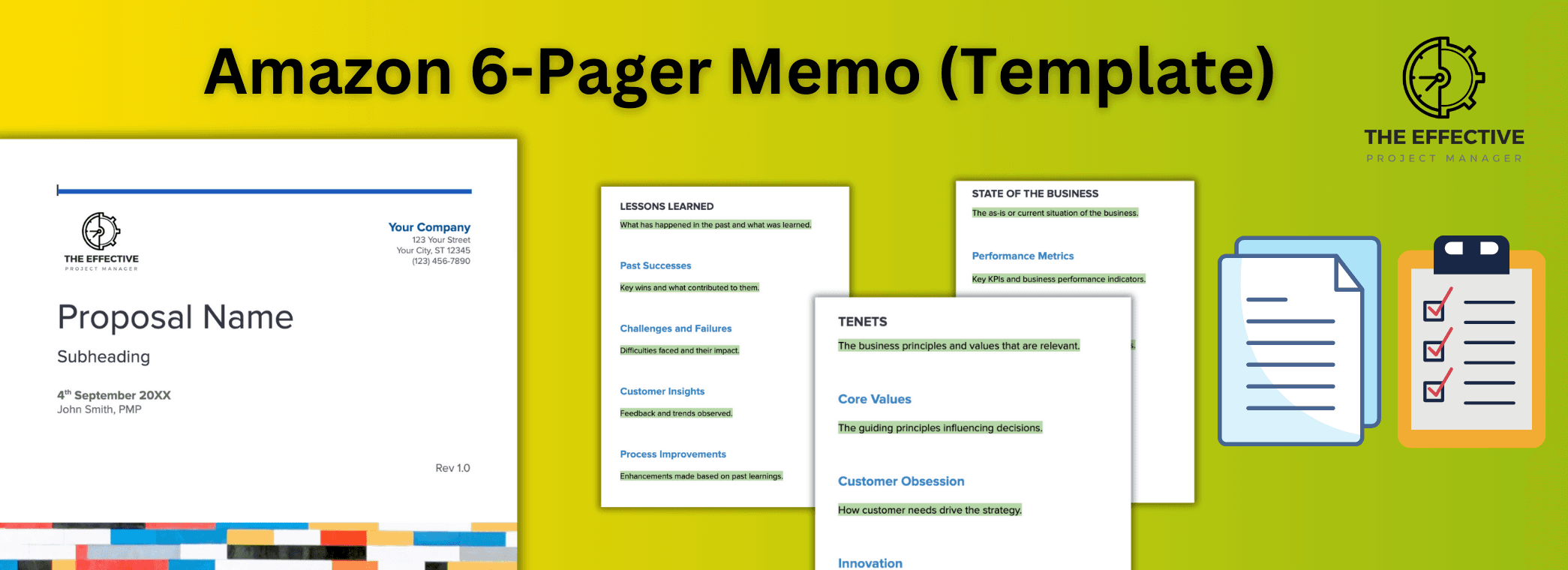Published in Productivity

Jonathan
The Effective Project Manager
January 28, 2024
The Amazon 6-Pager Memo: Better Than Powerpoint?
Discover the game-changing Amazon 6-Pager Memo method – a strategic decision-making approach transcending PowerPoint. Dive into Amazon's success journey and learn how this written narrative, emphasizing deep thinking and storytelling, streamlines meetings, fosters accountability, and ensures rational decisions. Uncover its benefits and explore how the 6-Pager method transforms project management, providing a structured guide for key decision points. Join the league of innovators as the 6-Pager memo proves to be a powerful tool, aligning teams and revolutionizing strategic decision-making in a fast-paced business world.
Who are Amazon?
Amazon's extraordinary success as one of the world's leading companies cannot be denied. From humble beginnings as an online bookstore to its current status as an e-commerce giant, Amazon has consistently pushed the boundaries of innovation and disruption. Amazon's achievements are a testament to the effectiveness of their practices. With a relentless focus on customer satisfaction, they have disrupted numerous industries, transformed the way people shop, and set new standards for convenience and efficiency. It is clear that Amazon's success is not a result of chance; rather, it is a direct outcome of their unique approaches and practices. Among these practices, the utilization of the famous 6-pager memo stands out as a compelling example. The fact that Amazon, with its immense scale and complexity, relies on a written document instead of conventional PowerPoint presentations speaks volumes about the effectiveness and impact of this approach.
What is the 6-pager memo?
When an organisation or team has an important decision to make, collaborative thinking is often required. Traditionally, the team will prepare a powerpoint presentation and present this verbally to the key senior decision-makers. The 6-pager memo concept takes a different approach. It gives the presenters the constraint that they must create a written memo, with a maximum length of 6 pages (and additional annexures). This written document is then discussed at a meeting where the final decision is to be made.
Unlike PowerPoint presentations, which often rely heavily on bullet points and visuals, the 6-pager memo focuses on written narratives. This forces the author to think deeply about the subject matter and present a logical flow of ideas. It also allows the reader to absorb information at their own pace and engage in detailed discussions.
The 6-pager memo is centered around seven main sections:
Introduction - Describes the background and intention of the report
Goals - Sets out key success metrics up-front
Tenets - The business principles and values that are relevant
State of the Business - The as-is or current situation of the business
Lessons Learned - What has happened in the past and what was learned
Strategic Priorities - The detailed plan for achieving the success metrics described earlier
Appendix - Additional data, tables, documents and context
The 6-pager memo is created by the meeting organiser or team. It is circulated before the meeting and then attendees are given 15-30 minutes at the beginning of the meeting to read the memo in silence. It is then discussed for the remainder of the meeting.

Get the best Amazon 6-Pager Memo template for your work here.
It’s greatest benefits
Having a pre-prepared memo focuses the meeting. The agenda is clear to all. This greatly reduces the time wastage caused by clarifying objectives at the beginning of the meeting.
The team creating the memo are forced to deeply understand the topic. More than if they simply presented it verbally. They are forced to give the advantages and disadvantages in a compelling but concise manner. Many ideas are found to be unfeasible in this analysis process and thus further time is not wasted.
One of the advantages of the 6-pager memo is its emphasis on storytelling. By presenting ideas in a narrative format, it becomes easier to captivate and persuade the audience. It helps to build a compelling case and align stakeholders around a common understanding.
Key decision-makers are often busy and don’t have time to read information up-front. Thus giving them dedicated reading time in the meeting makes them more likely to be focused and knowledgeable.
The detailed nature of the memo means that the strategic decision will be made based on the strength of the information and not the strength of the presenter’s personality or skill at speaking. This leads to more rational decisions.
Moreover, the 6-pager memo promotes a culture of accountability and ownership. When everyone involved reads and understands the memo, it ensures that discussions and decisions are based on the same information. It minimizes the risk of miscommunication and allows for meaningful collaboration.
The written format and time for reflection allows the decision-makers to slowly process the information at their own pace. They can also check back and forth through the document and do their own notes, calculation and analysis. This is more difficult when the data is presented and rapidly covered.
Although the 6-pager memo may seem time-consuming compared to creating PowerPoint slides, it can actually save time in the long run. By forcing the author to think through the details upfront, it reduces the need for multiple rounds of revisions and clarifications. It streamlines the decision-making process and enables teams to move forward more efficiently.
Being required to write a detailed, but concise, memo is a great skill for the team. Writing skills are of great importance.

Get our best ChatGPT Prompts for your work here.
How to use the 6-pager method for project management.
The Amazon 6-Pager method proves especially instrumental when confronted with significant strategic project decisions. The method offers a structured approach to decision-making that transcends the limitations of conventional presentation formats. The requirement to condense complex information into a concise, six-page document compels project teams to delve deeply into the intricacies of the decision at hand. By focusing on written narratives instead of bullet points and visuals, the 6-pager ensures that every aspect of the decision is thoroughly considered and presented with clarity.
Moreover, during high-stakes strategic decisions, where the impact can reverberate across the organization, the 6-pager method becomes a unifying force. It serves as a comprehensive guide for stakeholders, providing them dedicated reading time to absorb critical information before discussions commence. This structured approach minimizes the risk of decisions being swayed by charismatic presentations or surface-level arguments. Instead, the decision-makers engage with a detailed and well-thought-out document, fostering a rational and informed decision-making process. The 6-pager method thus becomes an invaluable tool for navigating the complexities of big strategic project decisions, ensuring that they are approached with depth, precision, and a shared understanding among key stakeholders.
Here are examples of strategic decision points within project management where the Amazon 6-Pager method can be effectively employed:
Project Kickoff and Chartering:
Before initiating a project, the 6-pager can define the project's purpose, goals, and key success metrics, providing a comprehensive foundation for the team to align on the project's strategic direction.
Resource Allocation and Budgeting:
When making decisions regarding resource allocation and budgeting, a 6-pager can outline the project's financial goals, resource requirements, and the strategic priorities for optimizing resource utilization.
Technology Integration Decisions:
For projects involving the integration of new technologies, the 6-pager can present the technological landscape, potential benefits, and the strategic plan for incorporating the technology seamlessly.
Project Phasing and Milestone Planning:
In the planning phase, the 6-pager can outline the project's milestones, phasing strategy, and the strategic priorities for achieving each milestone in a timely and efficient manner.
Project Scaling and Expansion:
In cases where the project scope expands, the 6-pager can articulate the reasons for expansion, the implications on resources, and the strategic roadmap for successfully scaling the project.
Vendor Selection and Collaboration:
When deciding on vendor partnerships, the 6-pager can highlight vendor evaluation criteria, alignment with project goals, and the strategic priorities for fostering a successful collaboration.
Change Management Strategies:
For decisions related to change management within a project, the 6-pager can outline the proposed changes, potential impacts, and the strategic plan for effectively managing and communicating changes to the team.
These examples illustrate how the Amazon 6-Pager method can be a valuable asset in project management, providing a structured and narrative-driven approach to key decision points, ultimately contributing to the success of the project.
Conclusion
In conclusion, the Amazon 6-Pager Memo emerges as a powerful alternative to conventional PowerPoint presentations, embodying the essence of Amazon's innovative and effective decision-making culture. Amazon's journey from an online bookstore to an e-commerce giant is a testament to the company's commitment to pushing boundaries, and the adoption of the 6-pager memo is no exception.
This unique approach, emphasizing written narratives over bullet points and visuals, reflects a dedication to deep thinking and strategic planning. The 6-pager memo's structure, from introduction to appendix, guides teams to thoroughly understand and present their ideas in a compelling and concise manner. By promoting storytelling, it not only captivates audiences but also aligns stakeholders, fostering a common understanding crucial for decision-making.
The memo's benefits are multifaceted. It streamlines meetings, providing clarity from the outset and minimizing time wasted on clarifying objectives. It instills a culture of accountability, ensuring that decisions are rooted in a shared understanding and not swayed by presentation skills. The emphasis on dedicated reading time for decision-makers encourages focus and enhances overall knowledge.
Furthermore, the 6-pager memo serves as a catalyst for rational decision-making, as decisions are based on the strength of information rather than the presenter's personality. It cultivates valuable skills within teams, emphasizing the importance of concise and impactful writing. While it may appear time-consuming initially, the memo ultimately accelerates the decision-making process, reducing the need for multiple revisions and clarifications.
In a fast-paced business environment, where time is a precious commodity, the 6-pager memo stands out as a tool that not only respects the busy schedules of decision-makers but also enhances the quality and efficiency of strategic decision-making. As Amazon continues to set new standards for innovation, the 6-pager memo remains a compelling example of how a simple, yet thoughtful, approach can revolutionize the way organizations make crucial decisions.
👋 To make things easier and save myself tons of time, I created a full template of the memo. If you want to grab it, have a look at the link below.

